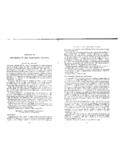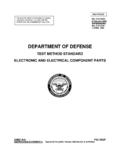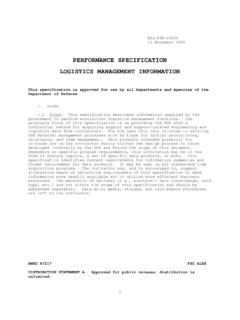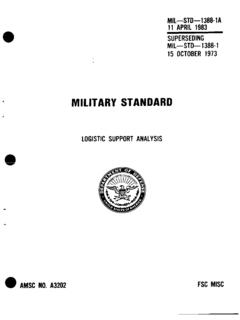Transcription of FRACAS - Barringer1.com
1 FRACASAn Acronym ForFailure Recording, Analysis, and Corrective Action SystemPaul Barringer, & Associates, Box 3985 Humble, TX 77347 Phone: 1 281 852 6810 Email: Barringer & Associates, Inc. 2015 For More Reliability Tools: See 17, 20151 FRACAS : What Is It? FRACASis an organized database for aiding in solving reliability problems using a common sense approach data for systematically and permanently removing failure mechanisms. What goes into the database: equipment IDs, ages to failure, suspended (censored) ages for removals before death (PMs, Optimum Replacements, etc.), reasons for failure or removals (broke and fixed are not sufficient details) and a host of other common sense Data To Acquire? Life data from equipment logs will contain True failures from breakdowns/predictive repairs ages to failure Suspended data for removals not yet failed ages to removal Suspended data for good maintenance replacements removals Ages to failure are times/cycles/stops starts/hot cold cycles, or what motivates failures You need the birth date and death date just as the requirement for your own death certificate the reason for failure must be identified3 What Specific Data Is Needed?
2 Three requirement for precise failures: The time origin must be unambiguous A scale for measuring passage must be set The meaning of failure must be entirely clear What failure data should you gather? First: Define what is a failure Second: Acquire data motivating the failure Third: Record exposure time to insults motivating failure Build a Weibull libraryfor wise use of your data it s your history!4 FRACAS : Why Is It Necessary? Use data to solve problems. Attack root causes to reduce/eliminate failures to make reliability grow and reduce costs. Fixing failures requires facts not opinions. Use the system closed loop to record, analyze, correct, and verify improvements have occurred. Remember first data reported is usually a SYMPTOMand NOTthe root cause for failures so the FRACAS system requires updates, corrections, and : When to use it? The maintenance repair order system generates evidence of a failure this is the starting point Failures with significant costs*must be investigated and evaluated to reduce future failures little is gained investigating trivial cost items use the $Pareto list, on the vital few $items, add details to records, and make big $improvements6*(repair costs + collateral damage + lost gross margin from the failure + other appropriate business costs such as $risk*POF) FRACAS : Where to use it?
3 This engineering tool requires clerical effort to input data and build the vital few details to identify significant eventsrequiring corrective actionin a timely manner along with root causes. Use the FRACAS tool to update management in terms of $ s, time/place to take action, and improvements achieved for controlling costs. FRACAS is not a clerical toy or bureaucratic tool!It is a useful and practical tool for improvements and communicating practical details up and down the management : In Summary Gather failure reports Do a failure analysis with ages to failure Understand the failure modes Mitigate failures including risk mitigation Demonstrate success by avoiding failures Include details in lessons learned library to train Communicate success/failures to management and the FRACAS teams Go to the next big item on the $Pareto list & repeat corrective actions using data8 What failedHow it failedWhy it failedNo future failuresShow successesTrainCommunicateRepeat overand over!
4 FRACAS : Resource Lists MIL HDBK 2155 (formerly MIL STD 2155) AMSAA Design For Reliability Handbook Reliability Program Requirements For Space And Lunch Vehicles, MIL STD 1543B Electronic Reliability Design Handbook, MIL HDBK 338A Weapon System Integrity Guide, MIL HDBK 515 Reliability Program For Systems And Equipment,MIL STD 7859 You can download these PDF s from













